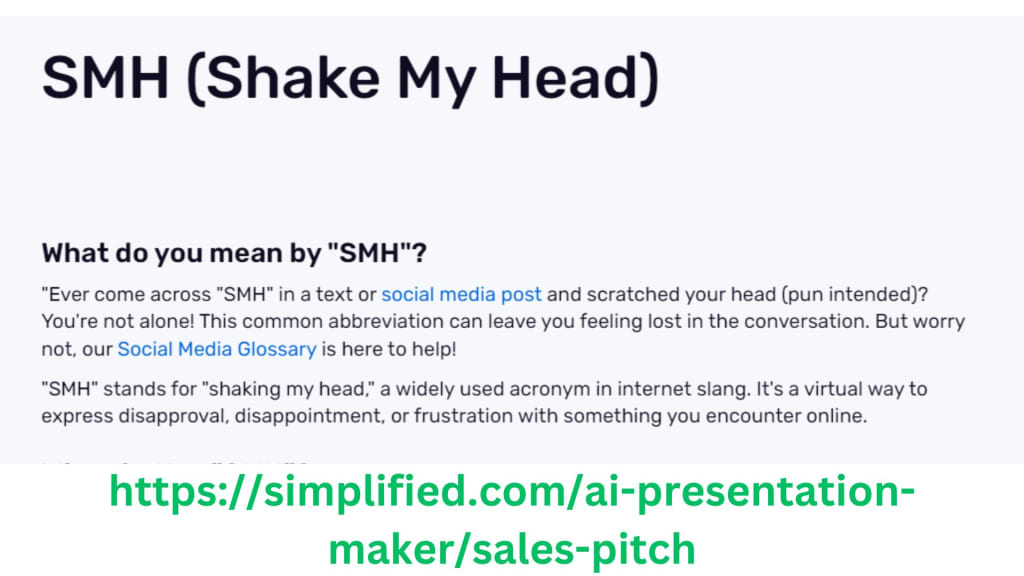SMH - Shake My Head: An Acronym Explained
SMH: Shake My Head - Internet Slang Decoded

In the dynamic and ever-evolving world of internet communication, acronyms and slang terms have become essential tools for conveying complex emotions and reactions quickly. One such term that has gained significant popularity is "SMH," which stands for "Shake My Head." This acronym encapsulates a range of emotions from mild disbelief to profound disapproval, making it a versatile and powerful tool in digital conversations. This post explores the meaning, origins, and everyday usage of SMH, providing a comprehensive understanding of this widely-used internet slang.
The Meaning and Origins of SMH
SMH meaning stands for "Shake My Head," and it signifies a gesture of shaking one’s head in disbelief, disappointment, or frustration. The acronym originated in the early days of internet communication, becoming widely recognized around 2010. Platforms like Twitter, Tumblr, and early chat rooms played a significant role in popularizing SMH. Its appeal lies in its brevity and ability to convey complex reactions with just three letters, making it an efficient way to express emotions in the fast-paced world of digital communication.
Everyday Usage of SMH
Social Media
On social media platforms such as Twitter, Facebook, and Instagram, SMH is commonly used to react to trending topics, news stories, and user-generated content. It often appears in comments, tweets, and posts, sometimes even as a hashtag. For example, if a public figure makes a controversial statement, users might respond with, "SMH, can't believe they said that," expressing their disbelief and disappointment succinctly.
Text Messaging
In personal text conversations, SMH serves as a quick and efficient way to respond to messages that elicit a reaction of disbelief or frustration. For instance, if a friend tells you they missed an important meeting because they overslept, you might reply with "SMH" to convey your disappointment without needing to write a lengthy message.
Memes and GIFs
SMH has become a staple in meme culture, often featured in memes and GIFs to add a visual element to the expression. Memes with captions like “SMH” or GIFs of people shaking their heads enhance the emotional impact and make the reaction more relatable. These visual representations add an extra layer of expression, making the sentiment even more impactful and engaging.
Everyday Conversation
Interestingly, SMH has transcended digital communication and entered spoken language, especially among younger generations. People might say “SMH” in real-life conversations to express the same sentiments they would online. This crossover into verbal communication underscores the influence of internet slang on everyday language and how digital culture shapes our communication habits.
Variations of SMH
Several variations of SMH have emerged to convey varying degrees of disbelief or frustration:
SMDH: Shake My Damn Head – Used for stronger emphasis on frustration or disbelief.
SMFH: Shake My F***ing Head – Used for extreme exasperation or anger.
These variations allow users to tailor their responses more precisely to the situation, providing a nuanced way to express their feelings.
While SMH is widely understood and accepted, it’s important to use it appropriately. Overusing acronyms can make your messages seem insincere or lazy. Additionally, in professional or formal contexts, it’s best to avoid slang and opt for more traditional expressions of disbelief or disappointment
Cultural Impact
The widespread use of SMH reflects broader cultural shifts in how we communicate. Internet slang like SMH allows for rapid, efficient communication that captures complex emotions in a compact form. It demonstrates how digital culture influences language, making communication more dynamic, expressive, and at times, more playful.
Proper Usage and Etiquette
While SMH is widely understood and accepted, it’s important to use it appropriately. Overusing acronyms can make your messages seem insincere or lazy. Additionally, in professional or formal contexts, it’s best to avoid slang and opt for more traditional expressions of disbelief or disappointment to maintain clarity and professionalism.
Conclusion
SMH, or Shake My Head, is more than just an acronym; it’s a powerful tool for expressing a range of emotions quickly and effectively. Its simplicity and versatility have made it a staple of internet communication, reflecting the ways we connect and react in the digital age. By understanding and appropriately using SMH, you can enhance your online interactions and better convey your feelings of disbelief or disapproval.
Read More - https://simplified.com/social-media-glossary/smh-shake-my-head
Address - USA,California
About the Creator
Enjoyed the story? Support the Creator.
Subscribe for free to receive all their stories in your feed. You could also pledge your support or give them a one-off tip, letting them know you appreciate their work.





Comments
There are no comments for this story
Be the first to respond and start the conversation.